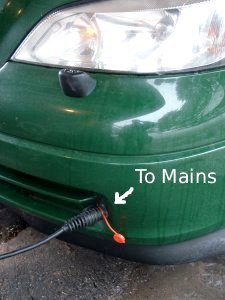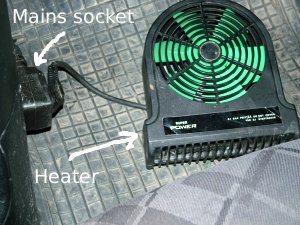|
Improving your gas mileage day by day MilesGallon.com - Gas Mileage CalculatorFind Out Your Real MPG and Learn How to Improve It Pictures of My Car Heating System
The first part is the timer that lets me connect the heating when I get home from work and have it turn on two to four hours before I go to work the next day. I use two hours during the mild part of winter and four hours when it’s really cold.
Inside the car the cabling goes to the block heater and to the inside heating fan. The cable outside the car should be made of oil and cold resistant material as otherwise it will get stiff as a stick and oil on the ground can eat through normal cabling.
As you can see it’s pretty crowded in the engine compartment so I didn’t find where the heater is located but it does work so I believe it’s where it’s supposed to be.
The block heater helps with mileage as the engine uses less fuel when warm and the inside heater lets me take off immediatly instead of idling for five minutes while taking the ice off the windows. It also make the driving a lot more comfortable as the engine does not heat up enought to provide much heat during my 15 mintue commute. Dedicated to improving your mileage, Simon Byholm
7 Ways to Stay Safe on Roads Slippery From Snow and IceWinter is here and where I live in Finland we have Yesterday I was doing a 60 mile trip on smaller It’s not really dangerous or difficult to drive on Rule #1: Slow down Whatever you do you can never reach the same speed Rule #2: Be really soft on the pedals Normally your car is rolling on four wheels, this On slippery roads if you press the gas pedal hard This turns your car into an object sliding in stead Rule #3: Keep your distance and slow down in time One of the most common accidents at winter is to The solution is to always maintain a good distance Always slow down when you come to a crossing, even Rule #4: Break safely If you lose control when breaking you will have to Sometimes the only way to avoid a accident is to not If your car is equipped with automatic breaking Rule #5: Accelerate safely Basically your car can either steer or accelerate. On Never accelerate when the road is turning, you need When accelerating too aggressively a rear wheel drive In case you’re car is equipped with a traction control Rule #6: Use good winter tires If you have snow and ice for over a month during You may also want to check your local laws and You can get good snow tires at a great price Rule #7: Practice and learn If you have a safe place to practice ice driving, In another blog post from this fall I teach how To learn your true gas mileage try the free gas
Copyright (C) 2006-2023 Text Ad King and MilesGallon.com - Gas Mileage Calculator
|
 I thought some of your may not have seen any engine heating system if you live south and as this one is connected to the Finnish electricity grid you won’t recognice the electricity connectors if you live outsitde this part of Europe.
I thought some of your may not have seen any engine heating system if you live south and as this one is connected to the Finnish electricity grid you won’t recognice the electricity connectors if you live outsitde this part of Europe. Then theres the cable connecting the mains from the timer to the car. Theres a small handy socket in the front left of the car where I plug in the power, we also have a couple of heating sockets at work so if I’m in time I can have heater on also before leaving for home.
Then theres the cable connecting the mains from the timer to the car. Theres a small handy socket in the front left of the car where I plug in the power, we also have a couple of heating sockets at work so if I’m in time I can have heater on also before leaving for home. I included a pic of the engine even though you can’t see the heater, it’s a block heater and if you could see it it would just be a cable going into the engine block as the heater is inside the engine heating the coolant.
I included a pic of the engine even though you can’t see the heater, it’s a block heater and if you could see it it would just be a cable going into the engine block as the heater is inside the engine heating the coolant. The other part of the heating system is a heating fan heating the inside of the car making it more comfortable and melting ice of the windows saving me five minutes of idling and manual ice-removal.
The other part of the heating system is a heating fan heating the inside of the car making it more comfortable and melting ice of the windows saving me five minutes of idling and manual ice-removal.